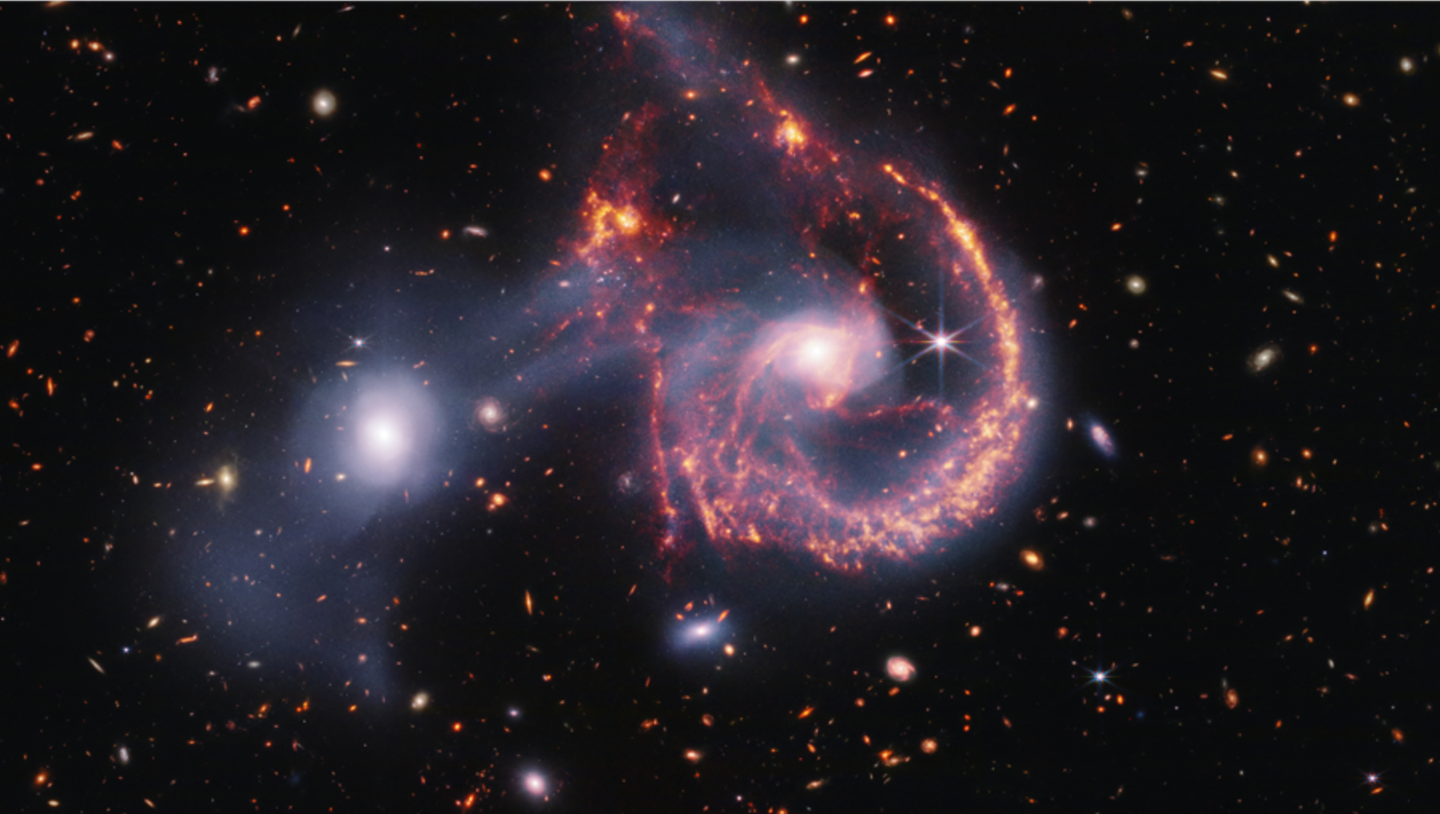Previously unseen phenomenon spotted in galaxy 12.9 billion light-years away
Instead of GS-NDG-9422’s stars dominating it’s emissions, its gas appears to shine the brightest, hinting at a rare stage in galaxy evolution.

A billion-year-old galaxy sheds light on early universe evolution with luminous gas. (CREDIT: NASA, ESA)
The James Webb Space Telescope has transformed how scientists study the universe. With its unmatched ability to detect near-infrared light, it reveals details of distant galaxies once thought impossible to observe.
Recent findings have not only mapped the structure of ancient galaxies but also uncovered unusual features that challenge existing models of early cosmic development. These discoveries push the boundaries of what astronomers expect to find in the distant past.
One galaxy, identified just a billion years after the Big Bang, has drawn particular interest. Known as GS-NDG-9422 (9422), it displays an extraordinary light pattern unlike anything seen before. Instead of its stars dominating the emission, its gas appears to shine the brightest, hinting at a rare transitional stage in galaxy evolution.
“My first thought in looking at the galaxy’s spectrum was, ‘that’s weird,’ which is exactly what the Webb telescope was designed to reveal,” said Alex Cameron of the University of Oxford. The data offer a fresh perspective on how the earliest galaxies in the universe may have formed and changed over time.
Working with theorist Harley Katz, Cameron analyzed the spectral data and found something remarkable. The stars within this galaxy appeared to reach temperatures beyond 140,000 degrees Fahrenheit (80,000 degrees Celsius)—far hotter than those found in today’s universe.
“It looks like these stars must be much hotter and more massive than what we see in the local universe,” said Katz. “That makes sense because the early universe was a very different environment.”
One striking aspect of 9422’s spectrum is the presence of a Balmer jump. This phenomenon occurs when ionized hydrogen captures electrons, releasing energy in the form of photons. The result is a noticeable discontinuity in the light spectrum.
While Balmer jumps occasionally appear in nearby galaxies, their presence at high redshifts suggests something unique. In this case, it likely signals the influence of young, highly energetic stars shaping the surrounding gas.
Related Stories
The nebular continuum contributing to the Balmer jump has three main components: free-bound, free-free, and two-photon emissions. Free-bound emission, linked to hydrogen recombination, dominates the spectra of galaxies like 9422.
Free-free and two-photon emissions typically remain subdominant due to insufficient ionizing photon production. However, extreme conditions, such as temperatures exceeding 140,000 degrees Fahrenheit (80,000 degrees Celsius), enable these less common emissions to rival or even surpass stellar light.
Two-photon emission, while rare, has been theorized to occur under specific conditions. Blackbody temperatures of 150,000 degrees Fahrenheit (85,000 degrees Celsius) or higher produce ionizing photons capable of driving this continuum. Observations of the Lynx arc, another extreme emission system, previously hinted at similar phenomena, but examples like galaxy 9422 provide more compelling evidence.
Galaxy 9422 offers insights into the nature of the universe’s first stars and galaxies. While it does not host Population III stars—the earliest, metal-free stars—its unusual stellar populations may serve as analogs for understanding galactic evolution from primordial to familiar forms.
Katz explained, “The exotic stars in this galaxy could be a guide for understanding how galaxies transitioned from primordial stars to the types of galaxies we already know.”
Modeling the spectrum of galaxy 9422 presents two plausible scenarios. The first involves a damped Lyman-alpha absorption system (DLA), which accounts for the ultraviolet continuum’s steep turnover. However, this explanation requires a highly specific geometry and extreme gas densities.
A second scenario suggests that nebular emissions, particularly two-photon and free-bound emissions, dominate the galaxy’s light. This would imply an ionizing source capable of outshining its stellar light, potentially indicating hot stars or unique configurations of nebular gas.
Cameron and Katz’s team hypothesize that 9422 could represent a brief, intense phase of star formation. During this time, dense gas clouds produce massive, hot stars emitting an extraordinary number of photons.
These photons energize the surrounding gas to such an extent that its emissions eclipse those of the stars themselves. This process could reflect a phase of galactic development rarely captured by observations.
The implications of galaxy 9422 extend far beyond its individual characteristics. It raises fundamental questions about the prevalence of such conditions in the early universe. Are these phenomena common among galaxies of similar age, or does 9422 represent an outlier? The answers could reshape our understanding of the first billion years of cosmic history.
To unravel these mysteries, astronomers are actively searching for other galaxies with similar spectral features. Each discovery could provide additional pieces to the puzzle of how the universe’s first galaxies evolved.
“It’s a very exciting time to be able to use the Webb telescope to explore this time in the universe that was once inaccessible,” Cameron said. “We are just at the beginning of new discoveries and understanding.”
The study of galaxy 9422 is detailed in the Monthly Notices of the Royal Astronomical Society, marking another step in the ongoing quest to understand our cosmic origins.
Note: Materials provided above by The Brighter Side of News. Content may be edited for style and length.
Like these kind of feel good stories? Get The Brighter Side of News' newsletter.



